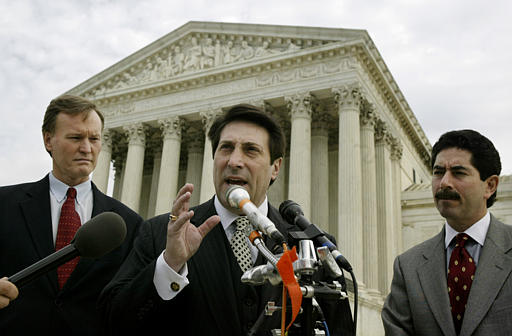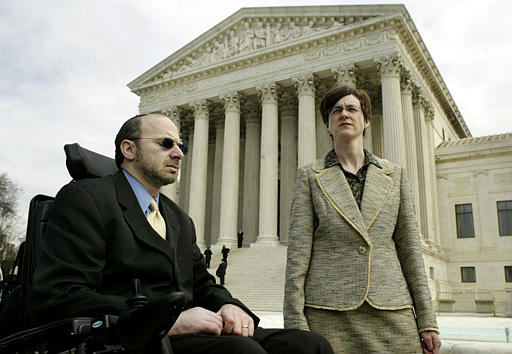Congress passed the Child Online Protection Act of 1998 (COPA) with the intent of preventing minors from accessing obscene material on commercial Web sites.
COPA targeted the Internet transmission of material harmful to minors
COPA was enacted as Title XIV of the Omnibus Appropriations Act for FY 1999 after the courts in Reno v. American Civil Liberties Union (1997) struck down the Communications Decency Act (CDA) of 1996, which banned online child pornography.
President Bill Clinton signed COPA into law in October 1998. Narrower than the CDA, the Child Online Protection Act targeted the Internet transmission of material harmful to minors distributed for commercial purposes.
The courts have long accepted that the First Amendment rights of minors are more restricted than those of adults, as happened in Bethel School District No. 403 v. Fraser (1986), Hazelwood School District v. Kuhlmeier (1988), and Morse v. Frederick (2007).
The courts have also acknowledged, however, that First Amendment rights of adults cannot be used as a rationale for endangering children. In New York v. Ferber (1982), a unanimous Court held that the First Amendment does not protect child pornography.
Congress used Miller test in devising law to determine obscenity
Members of Congress had hoped to bypass challenges to COPA by banning only material deemed harmful to individuals under 17 years of age.
“Harmful” was defined as pictures, images, graphic image files, articles, recordings, writings, or other communications that violate accepted standards for determining obscenity as established by the Supreme Court in Miller v. California (1973).
Lawmakers used the three-tier Miller test in COPA to classify material as obscene if taken as a whole:
- an average person would find it appealing to “prurient” or perverted interests;
- it offensively portrays “actual or simulated sexual act or sexual contact, an actual or simulated normal or perverted sexual act, or a lewd exhibition of the genitals or post-pubescent female breast”; and
- taken as a whole it lacked “serious literary, artistic, political, or scientific value for minors.”
Law applied only when commercial transactions occurred
Congress applied the ban only to communications involved in commercial transactions on publicly accessible Web sites.
COPA defined commercial dealings as those actions that make online material available for access through the process of requiring credit cards, debit accounts, adult access codes, adult personal identification numbers, or by accepting digital certification of age or other technological means of ascertaining whether clients are over the age of 17.
Monetary penalties were to be levied for each separate violation in which a minor accessed obscene material.
COPA was scheduled to take effect in November 1998, but a coalition of civil liberties groups successfully delayed implementation by challenging its constitutionality.
Civil liberties group say law limited First Amendment rights of adults
The coalition argued that COPA violated the First Amendment rights of adults by limiting their ability to receive and send information via the Internet. Assuming that COPA would ultimately be overturned, a Philadelphia federal district court granted an injunction, which the Third Circuit Court of Appeals upheld in June 2000.
The appeals court applied strict scrutiny in determining constitutionality because of COPA’s alleged limitations on First Amendment rights.
Although the appeals court accepted the responsibility of Congress to protect minors, it found COPA too broad for its intended task. The court also observed that COPA was inefficient — minors with credit or debit cards could easily bypass restrictions — and that minors would still be able to access obscene material on noncommercial or international sites.
In addition, the court held that “community standards” could not be applied to Internet sites, which by definition observed no geographic boundaries.

Chief Counsel for the American Center for Law and Justice Jay Sekulow, center, gestures during a news conference outside the Supreme Court on Tuesday, March 2, 2004 in Washington. Sekulow is arguing for the 1998 Child Online Protection Act that would make it a crime for commercial Web sites to knowingly place material that is “harmful to minors” within their unrestricted reach. (AP Photo/Evan Vucci, used with permission from the Associated Press)
Court considers community standards for obscenity on Internet
In November 2001, the Supreme Court agreed to address the issue of “community standards” as applied in COPA. In Ashcroft v. American Civil Liberties Union (2002), a plurality of the Court rejected the lower court ruling.
In five separate opinions, the justices held that using community standards to determine obscenity did not automatically invalidate COPA.
Justices Sandra Day O’Connor and Stephen G. Breyer suggested that a national standard would be needed for determining obscenity on the Internet.
Law found to be overly broad in limiting free speech rights
Without lifting the injunction, the Court remanded the case to the Third Circuit. Employing the standard of overbreadth, the appeals court again found COPA unconstitutional, determining that it limited the First Amendment rights of adults in the process of protecting minors.
The Supreme Court reaffirmed this ruling in Ashcroft v. American Civil Liberties Union (2004).
On remand, a federal district court granted a permanent injunction against the enforcement of COPA in March 2007 in American Civil Liberties Union v. Gonzalez (E.D. Pa. 2007).
This article was originally published in 2009. Elizabeth Purdy, Ph.D., is an independent scholar who has published articles on subjects ranging from political science and women’s studies to economics and popular culture.

